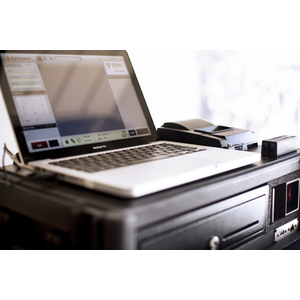When we started Shopbox Retail in 2010, we set out to build an outstanding point-of-sale (POS) system that businesses of all types and sizes could use to stage successful pop-up stores, warehouse sales, and other temporary retail events. We accomplished that goal, but at first we didn’t give much thought to packaging or ease of use. We were just focused on creating great technology.
In the beginning, when a client wanted to stage an event, we put all of the register and server components in a box and shipped them to the event site. When the box arrived, all those pieces had to be assembled, plugged in, and configured correctly. That meant we had to go to every event. Every time. Because the people staffing the events didn’t have the specialized knowledge necessary to put together a secure system. Clearly, we needed a different strategy.
We approached this problem the same way we would tackle a software development project:
Identify assumptions and dependencies based on actual pain points Assess what needs to happen to address all relevant issues Design a path forward to achieve those goals.
We knew from experience most of the problems that can occur at retail events. Time and space are often limited. There’s no time for troubleshooting or replacing lost parts, the right tools are rarely available, and there’s no room to set up complex systems with a tangle of cords running between multiple components. There’s also no guarantee of a reliable power source or Internet connection, and it’s unrealistic to expect the on-site sales staff to have specialized IT knowledge.
We knew that our next-generation POS systems would have to solve all of these problems to provide a seamless, worry-free experience for our clients. We also knew one other thing with absolute certainty. Our system would have to work. Every time. No exceptions. Failure was not an option.
We decided to automate everything and eliminate human error as much as possible. Everything that a human could potentially mess up, we bolted down or automated.
We designed a portable, durable case for our POS systems, which is both waterproof and shockproof when closed. Everything is pre-assembled and preconfigured, and all of the components are bolted into the case so that parts don’t get lost. Just take off the lid and plug it in. Simple.
We based everything on laptop versus desktop technology, so instead of forcing our clients to struggle with towers and peripherals while crawling under tables on their hands and knees to set up the POS system for their event, everything is already integrated and ready to go when they flip the switch. Each register gets a unique fingerprint, and the network is set to turn on registers and assign addresses in the right order. It’s like a string of Christmas lights; you plug it in and everything just works.
What we ended up creating is a turnkey solution for pop-up stores that takes the stress and risk out of two of the most complex tasks of any retail event—setting up and tearing down—so our clients can focus on other priorities. Even the most inexperienced person can set up one of our POS systems correctly and have it operating in minutes. In addition, every component is configured to work with everything else, so we can split off registers and servers as needed and ship them to different client events without reconfiguring. And event staff can submit sales information to the retailer’s backend system with one click of a single button.
We don’t claim that Shopbox Retail POS systems are all things to all retailers. They’re not meant to handle every possible retail contingency. Our systems are designed to provide fast, secure transactions in almost any location, and to be extremely easy to use and virtually foolproof. In the unlikely event that something does go wrong, after six years and hundreds of events it’s almost certain that we have seen and solved that something before. Our support personnel are there to fix it – in real time.
We went with “just remove the lid” because at events and pop up stores our clients need to focus on customers, not IT or point-of-sale problems.


